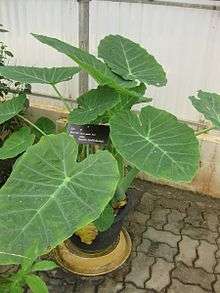Colocasia gigantea
| Colocasia gigantea | |
|---|---|
 | |
| Scientific classification | |
| Kingdom: | Plantae |
| Clade: | Angiosperms |
| Clade: | Monocots |
| Order: | Alismatales |
| Family: | Araceae |
| Genus: | Colocasia |
| Species: | C. gigantea |
| Binomial name | |
| Colocasia gigantea (Blume ex Hassk.) Hook.f. | |
Colocasia gigantea, also called giant elephant ear or Indian taro, is a 1.5–3 m tall herb with a large, fibrous, inedible corm, producing at its apex a whorl of large leaves.[1] The leaf stalk is used as a vegetable in some areas in South East Asia and Japan.
Known as bạc hà in southern Vietnam and by Vietnamese speakers in the U.S (while it is called dọc mùng[2][3][4] and bạc hà refers to a culinary mint herb in northern Vietnam[5]), it is often used in canh chua and bún (rice vermicelli soup). In northern Vietnam, it's known as dọc mùng or rọc mùng.
In Japanese, it is called hasu-imo[6] (literally, "lotus yam") in general and ryukyu in Kōchi Prefecture as it is originated in Ryukyu Kingdom. It is sometimes used as an ingredient of miso soup, chanpurū and sushi. A Japanese term zuiki means the leaf stalk of both C. gigantea and C. esculenta. Higo-zuiki, made of a dried stalk and produced solely in Kumamoto Prefecture (or Higo Province), is a sex toy with a history of several hundred years, containing saponin which is considered to affect sexual pleasure.
Colocasia gigantea is close to Alocasia macrorrhizos and is thought to be produced from natural crossing between A. macrorrhizos and C. esculenta.[7]
References
- ↑ Anton Ivancic et al. Thermogenesis and flowering biology of Colocasia gigantea, Araceae Archived 2013-10-29 at the Wayback Machine. J Plant Res (2008) 121:73–82.
- ↑ Nguyen Thi Ngoc Hue 'Taro diversity and use in Vietnam'. Ethnobotany and genetic diversity of Asian taro: focus on China
- ↑ Loài Dọc mùng Tri thức việt - Vietgle.
- ↑ MATSUDA M and NAWATA E "Taro in Northern Vietnam : Its Uses, Cultivation, and Genetic Variation" Japanese Journal of Tropical Agriculture, VOL.46;NO.4;PAGE.247-258(2002)
- ↑ Cultivated Plant Collections from Market Places My Lien Thi Nguyen
- ↑ Nguyen Thi Ngoc Hue 'Taro diversity and use in Vietnam' Ethnobotany and genetic diversity of Asian taro: focus on China
- ↑ The Global Diversity of Taro Ethnobotany and Conservation Bioversity International
| Wikimedia Commons has media related to Colocasia gigantea. |